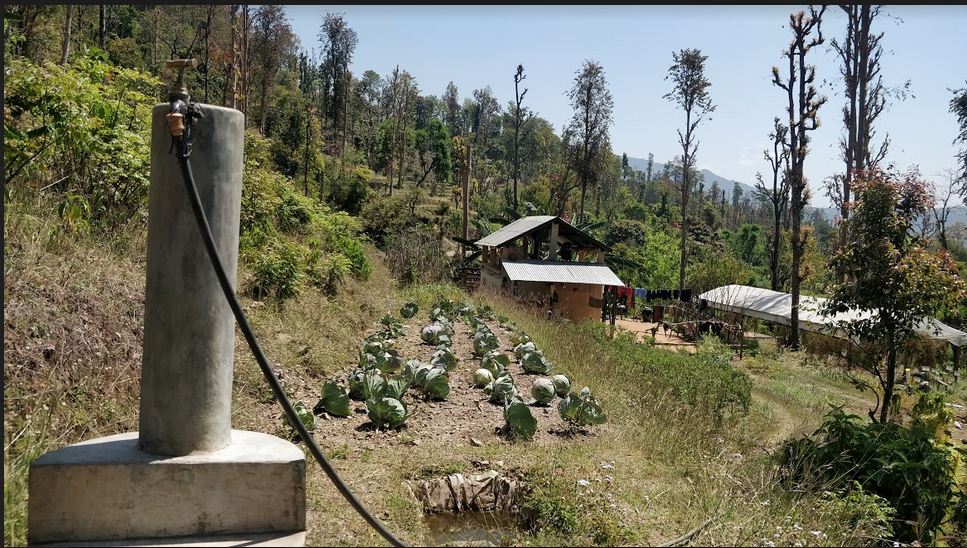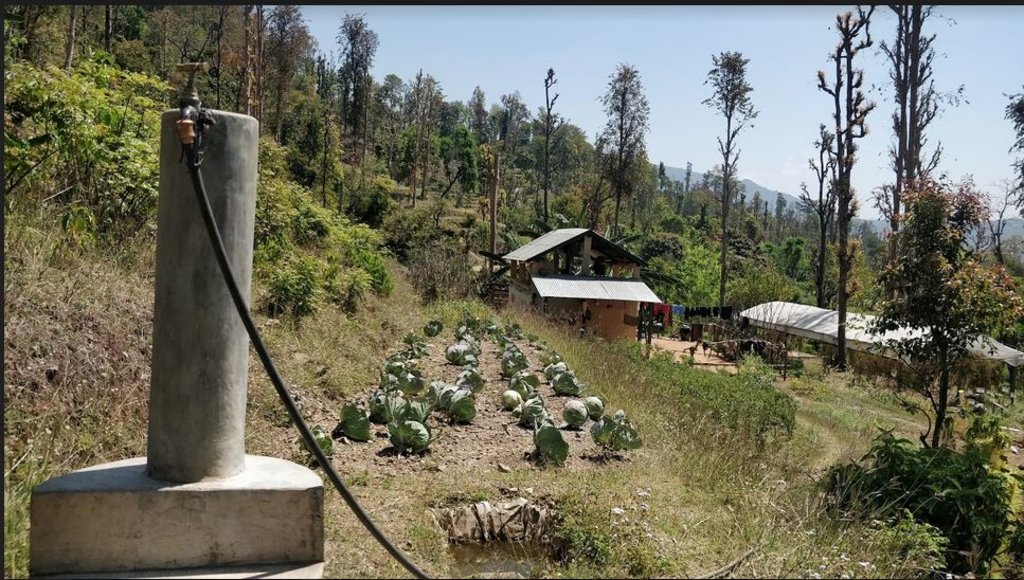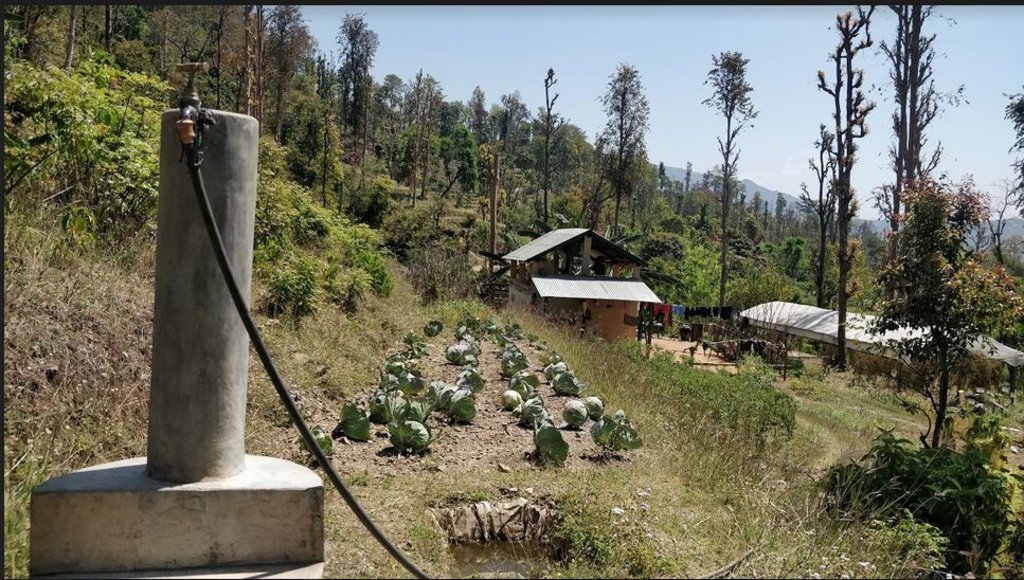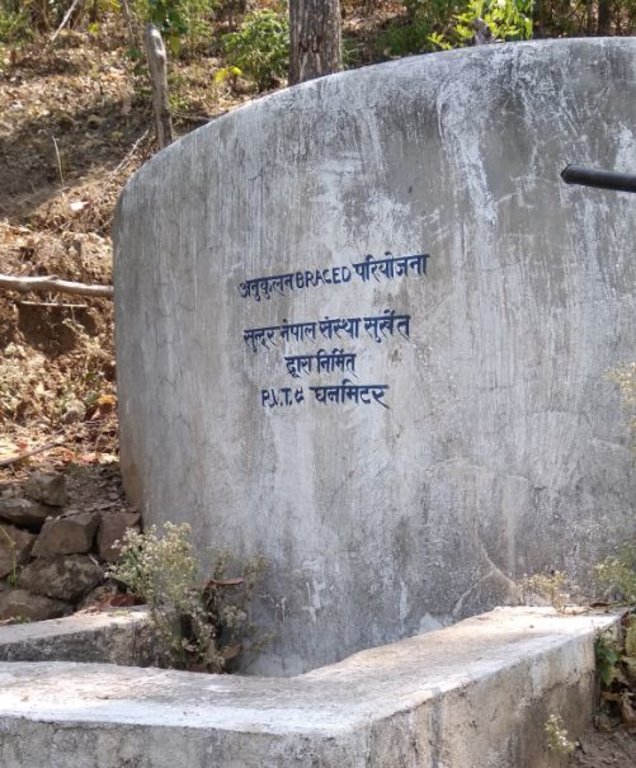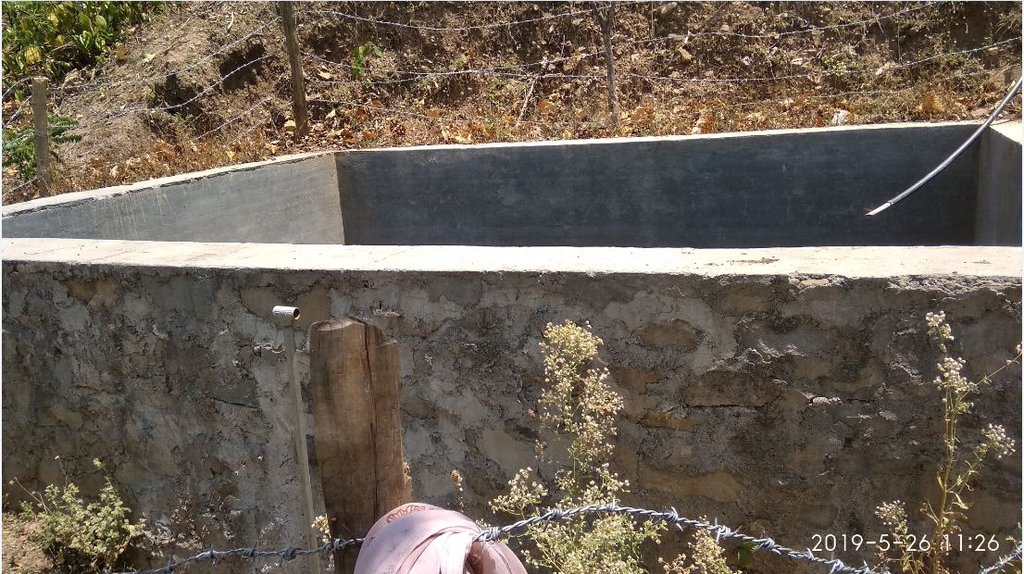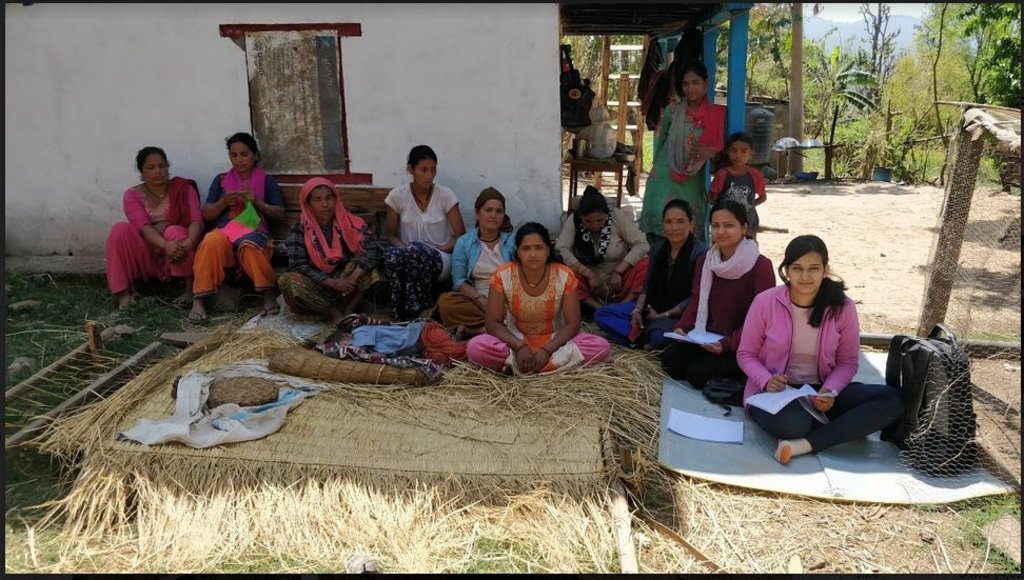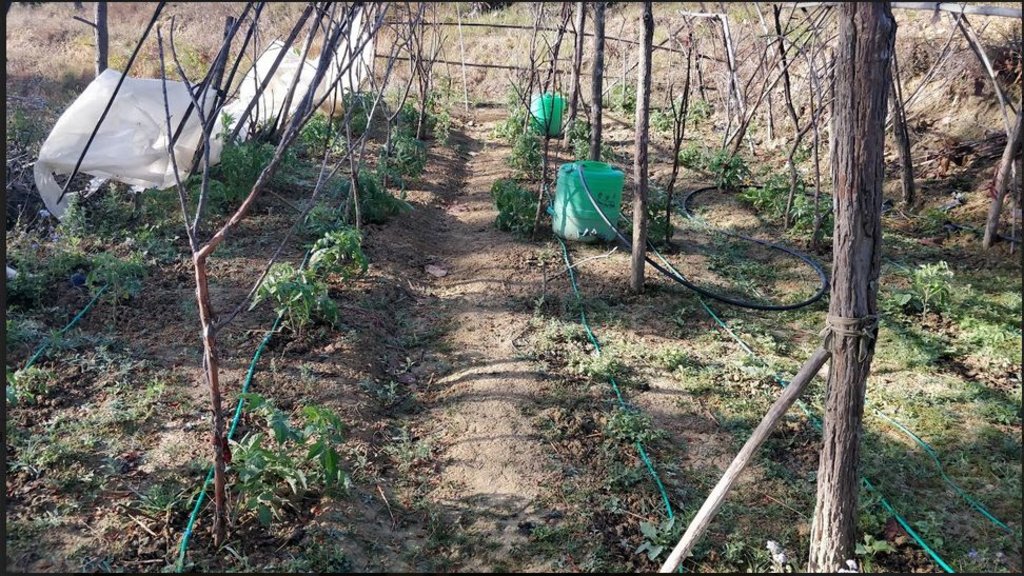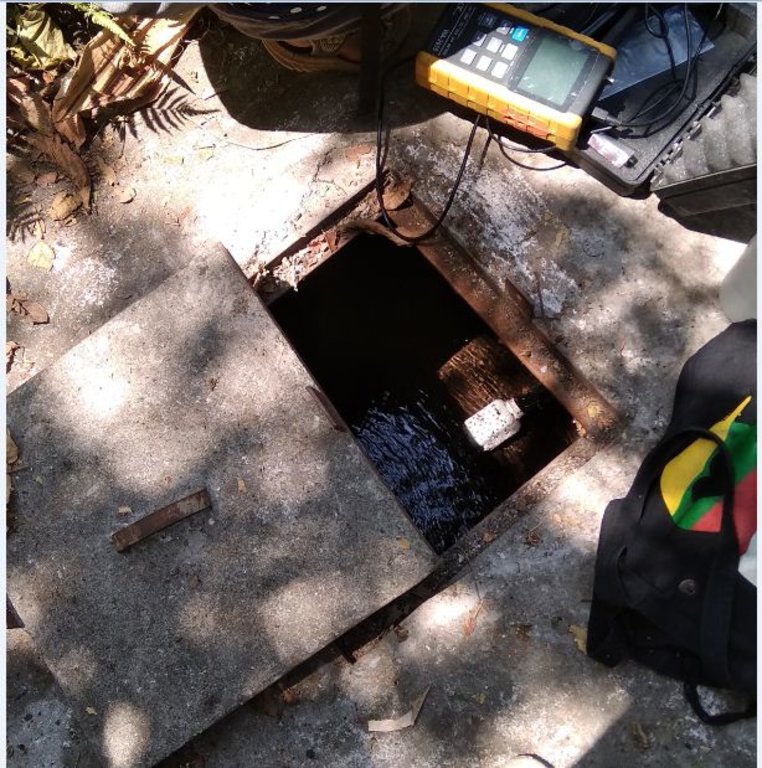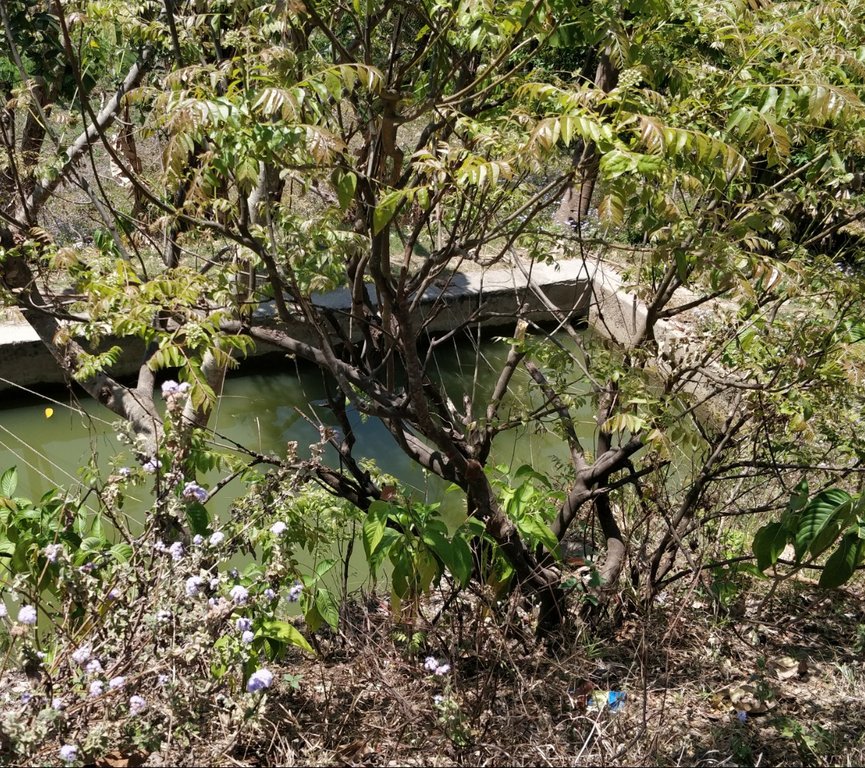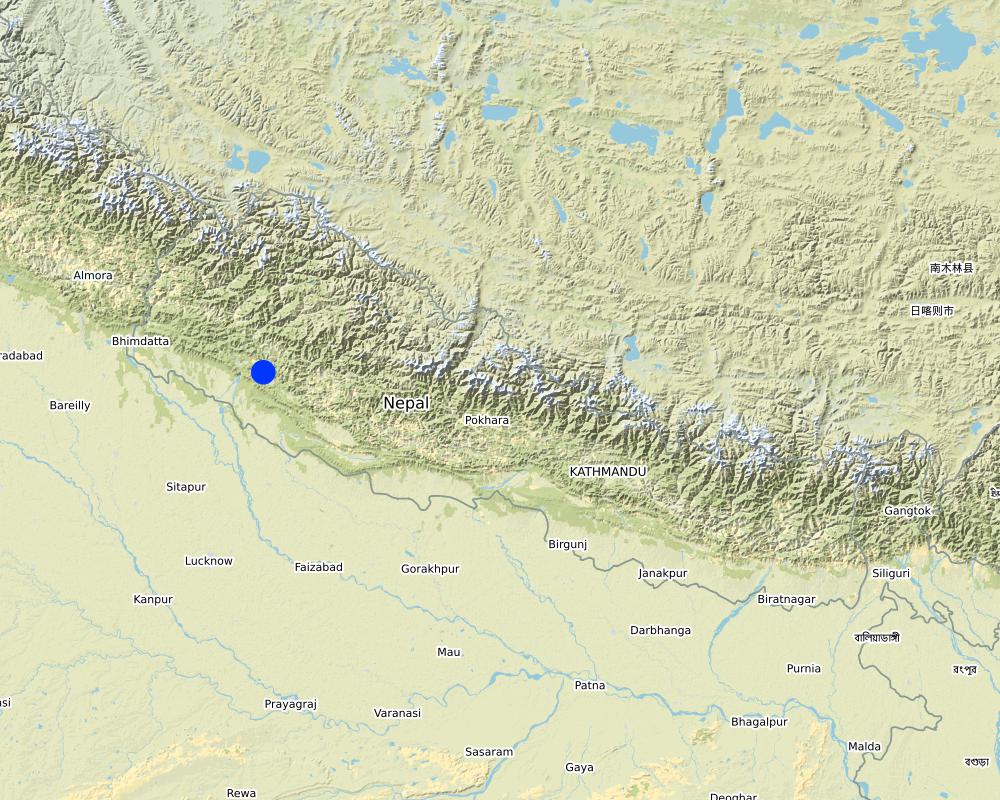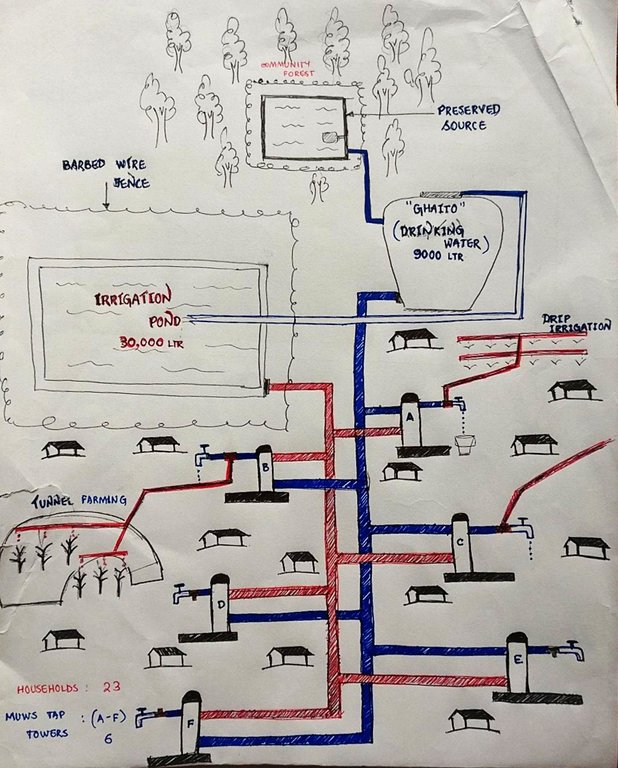Multiple Use Water System ( Gravity-Fed ) [Népal]
- Création :
- Mise à jour :
- Compilateur : Jhuna Kattel
- Rédacteur : –
- Examinateur : Renate Fleiner
Saajh Pani Ghaito
technologies_5200 - Népal
Voir les sections
Développer tout Réduire tout1. Informations générales
1.2 Coordonnées des personnes-ressources et des institutions impliquées dans l'évaluation et la documentation de la Technologie
Personne(s)-ressource(s) clé(s)
Water User:
B.K. Amrita
Népal
Nom du projet qui a facilité la documentation/ l'évaluation de la Technologie (si pertinent)
Prospects and challenges of water use systems as climate adaptive option for sustainable water management in Himalayan RegionNom du ou des institutions qui ont facilité la documentation/ l'évaluation de la Technologie (si pertinent)
Kathmandu University (KU) - Népal1.3 Conditions relatives à l'utilisation par WOCAT des données documentées
Le compilateur et la(les) personne(s) ressource(s) acceptent les conditions relatives à l'utilisation par WOCAT des données documentées:
Oui
1.4 Déclaration sur la durabilité de la Technologie décrite
Est-ce que la Technologie décrite ici pose problème par rapport à la dégradation des terres, de telle sorte qu'elle ne peut pas être déclarée comme étant une technologie de gestion durable des terres?
Non
Commentaires:
The technology used serves as a source of providing water for drinking and other multiple uses; such that it acts as a means to conserve and manage water resources rather than degrade them.
2. Description de la Technologie de GDT
2.1 Courte description de la Technologie
Définition de la Technologie:
Natural water source in hill top is collected in a small reservoir-chamber ( to preserve natural source), then passes onto a Reservoir Tank (RVT) for drinking water (ferro-cement tank/ Ghaito) with a capacity of 9000L that falls within individual’s plot of land. When the ferro-cement tank gets filled, water overflows, is collected in another reservoir pond (30,000L) for irrigation and other multiple uses. From the Ghaito and reservoir pond, two pipelines are fed and water is supplied into individual Multiple Use Water System (MUWS) tap towers.
2.2 Description détaillée de la Technologie
Description:
The technology is applied in a natural environment. The place of study falls under the dry belt of Nepal, receiving less than average annual rainfall (in context of Nepal). The source of water is natural that is located within a community forest area (samudayik ban), which is owned by the government and consists of trees like Sal, Supari (areca nuts), etc. From there, water collects onto a Ghaito / ferro-cement tank, which falls on the land owned by Mr. Krishna Bahadur B.K., who voluntarily agreed to donate the land for its construction. The total area covered for the tank is 1 ropani (1 hectare = 19.65 ropanis). From the reservoir, water is collected in a ferrocement tank / Ghaito / Thulo tanki (for drinking water) and a reservoir pond (for irrigation). Poly Vinyl Chloride (PVC) pipes are fed onto the tanks to distribute the water for multiple purposes in 6 Multiple Use Water System (MUWS) tap-towers; which consist of two faucets each - one for drinking and the other for irrigation and other purposes.
The major purposes of this technology are to supply clean water for drinking and other purposes to the community that is comprised of 23 households, through a cheap, effective and simple system. For establishing the system, labour and construction materials were needed for building Ghaito and pipeline systems. For the maintenance, manual labour is necessary. The natural source of water is locally maintained. The quality of the water that is supplied to the 23 households is good and the quantity seems sufficient for the number of households. Operation and maintenance works are done by the locals who collect NPR. 50 from each household. The system is guarded by a watchman (Chaukidar) who is given a monthly stipend of NPR. 800 from the committee. The system was financed through a public-private-partnership (PPP) program; out of which some amount was funded by a Non-Governmental Organization (NGO) - Sundar Nepal, primary survey of the natural source of water was done by another NGO- Anukulan Project with the help from UK-AID (NPR. 1,46,000) , and the remaining funds were contributed by the locals’ group (NPR. 1,39,183), by collecting NPR. 3000 initially then NPR. 1200 from each household. The then Village Development Committee (VDC) donated NPR. 1,00,000 and labour costs borne by the locals amounted to NPR. 85,600. Total amount invested for the project amounted to NPR. 4,70,783. Benefits of the technology are the sustainable use of water resources through a MUWS system, cheap and effective way to conserve water resources and the ensured availability of clean water even through dry seasons. The villagers like the facts that the water is clean, more water is available for irrigation for vegetable farming, and that their day-to-day life is simplified. They dislike the limited availability of water during dry season and that out of 6 systems only 3 are in operation and the other ones are in a non-working condition.
A separate committee is set up for the smooth operation of the system, which consists of 20 members- 10 males and 10 females. The head of the committee is Mrs. Amrita B.K.. The committee conducts a monthly meeting on 10th of each Nepalese month to discuss the problems and need of maintenance. During the initial setup, the connection of pipelines from the tap systems to the reservoir tanks was, however, done with the contribution of the locals. Every month, each family contributes NPR 50, which goes to a fund that is set up for the times of need. The labor contribution by the people of the VDC was dependent upon the number and availability of family members in the household. Similarly, the use of MUWS system and water from it is also dependent upon the availability of family members. Little to no maintenance was done to the system till now from 2073 B.S. ( 3 years) . Equal number of male and female members are in the committee dedicated to the MUWS system.
2.3 Photos de la Technologie
Remarques générales concernant les photos:
Ghaito/ Ferrocemetn tank for drinking water, Irrigation pond, the committee, MUWS tower and tunnels with drip irrigation are shown in the images
2.5 Pays/ région/ lieux où la Technologie a été appliquée et qui sont couverts par cette évaluation
Pays:
Népal
Région/ Etat/ Province:
Province-6, Mid-Western Development Region
Autres spécifications du lieu:
Kunathari VDC-5, Saajh Pani, Barahataal, Badichaur
Spécifiez la diffusion de la Technologie:
- appliquée en des points spécifiques ou concentrée sur une petite surface
Est-ce que les sites dans lesquels la Technologie est appliquée sont situés dans des zones protégées en permanence?
Non
Map
×2.6 Date de mise en œuvre de la Technologie
Indiquez l'année de mise en œuvre:
2015
2.7 Introduction de la Technologie
Spécifiez comment la Technologie a été introduite: :
- par le biais de projets/ d'interventions extérieures
Commentaires (type de projet, etc.) :
Sundar Nepal- a non governmental organization helped initiate the project
UKAID ( Anukulan Project) - an inernational non governmental project ( INGO ) helped with the technical aspects of the project
3. Classification de la Technologie de GDT
3.1 Principal(aux) objectif(s) de la Technologie
- améliorer la production
- réduire, prévenir, restaurer les terres dégradées
- s'adapter au changement et aux extrêmes climatiques et à leurs impacts
- créer un impact économique positif
- improve water security and increase efficient use at a household level
3.2 Type(s) actuel(s) d'utilisation des terres, là où la Technologie est appliquée

Terres cultivées
- Cultures annuelles
- Cultures pérennes (non ligneuses)
Cultures annuelles - Précisez les cultures:
- céréales - orge
- céréales - maïs
- céréales - riz (de terres humides)
- céréales - blé d'hiver
Cultures pérennes (non ligneuses) - Précisez les cultures:
- noix d'arec
- bananier/plantain/abaca
- canne à sucre
Nombre de période de croissance par an: :
- 3
Précisez:
The water used for irrigation is used in fields for 2-3 cycles of crop growing (annual) like rice, maize and barley and into kitchen-farming/tunnel farming (perennial) where vegetables grown are cucumber, tomatoes, chilli, bitterguard, peas, etc.
Est-ce que les cultures intercalaires sont pratiquées?
Non
Est-ce que la rotation des cultures est appliquée?
Oui
Si oui, veuillez préciser:
Rice, Maize and Wheat are cycled according to the seasons.

Autre
Précisez:
Drinking Water
Remarques:
Drinking water used directly from the tap systems. Some boil it but most of them use it straight from the tap systems and consume without filtration.
Commentaires:
Irrigation and Multiple Uses: The locals use the technology in order to irrigate their cropland so that the plant productivity is increased. As well, the introduction of this technology has opened up doors to new possibilities like construction of tunnels ( green houses) so that the locals can grow seasonal and off-seasonal vegetables in their backyards. Animal husbandry has also been an increasing practice. Human uses like washing, cooking, cleaning, bathing, etc are amply sufficient due to adequacy of water from this technology.
3.3 Est-ce que l’utilisation des terres a changé en raison de la mise en œuvre de la Technologie ?
Est-ce que l’utilisation des terres a changé en raison de la mise en œuvre de la Technologie ?
- Oui (Veuillez remplir les questions ci-après au regard de l’utilisation des terres avant la mise en œuvre de la Technologie)

Terres cultivées
- Cultures annuelles
- Cultures pérennes (non ligneuses)
Cultures annuelles - Précisez les cultures:
- céréales - orge
- céréales - maïs
- céréales - riz (de terres humides)
- céréales - blé d'hiver
Cultures pérennes (non ligneuses) - Précisez les cultures:
- bananier/plantain/abaca
Est-ce que les cultures intercalaires sont pratiquées?
Non
Est-ce que la rotation des cultures est appliquée?
Non
Commentaires:
Before the introduction of the technology, the land productivity was minimal. Water for human uses like bathing, cleaning, washing, cooking, etc. were scarce; especially during the dry seasons. No green houses were constructed. They used to rear very few cattle.
After the technology, vegetables from green houses in their backyards are sold to markets, which has acted as an alternative source of earning perennially.
3.4 Approvisionnement en eau
autre (par ex., post-inondation):
- Natural source (Mool) of water in foliage atop a hill that falls under Mr. Krishna Bdr. B.K.'s land
Commentaires:
The supply of water comes from a natural source ( 'mool' in local language) , where a small enclosure is constructed so that the source is preserved and water is amply supplied to the ferro-cement tank for drinking purposes ( 'Ghaito' in local language) and the reservoir pond for irrigation purposes.
3.5 Groupe de GDT auquel appartient la Technologie
- récupération/ collecte de l'eau
- gestion de l'irrigation (incl. l'approvisionnement en eau, le drainage)
- Gravity Fed Multiple Use Water System (MUWS) , New Scheme
3.6 Mesures de GDT constituant la Technologie

structures physiques
- S5: Barrages/retenues, micro-bassins, étangs
- S6: Murs, barrières, palissades, clôtures
- S7: Collecte de l'eau/ approvisionnent en eau/ équipement d'irrigation
- S11: Autres
Commentaires:
The technology is comprised of structures like Tanks (ferro-cement), Ponds (Concrete), Pipes, etc which use a myriad of resources like cement, iron rods, PVC pipes, fences for enclosure, etc.
3.7 Principaux types de dégradation des terres traités par la Technologie

dégradation hydrique
- Hs: changement de la quantité d’eau de surface
- Hp: baisse de la qualité des eaux de surface
Commentaires:
Before setting up the technology, much of the water during dry seasons would evaporate from the natural source ( mool) and there would be scarcity of water during dry seasons. This has been addressed by the technology, where securing the natural source of water prevented evaporation and storing water in enclosed tanks helped supply water during dry seasons.
Similarly, due to no preservation of the source and no storage tanks, the water would be soiled by sediments, wastes and insects' larvae. After setting technology up, the quality of water has vastly improved as well
3.8 Prévention, réduction de la dégradation ou réhabilitation des terres dégradées
Spécifiez l'objectif de la Technologie au regard de la dégradation des terres:
- prévenir la dégradation des terres
Commentaires:
The technology prevents water source degradation, improves perennial water availability, reduces effects like drought, floods, etc. Thus, land degradation by means of lands turning barren, dry,etc is tackled by this technology.
4. Spécifications techniques, activités, intrants et coûts de mise en œuvre
4.1 Dessin technique de la Technologie
Spécifications techniques (associées au dessin technique):
Source: Natural (mool) atop a small hill, secured by wire fences and preserved with concrete and metal lid ( to prevent evaporation).
Water from source collected in Ferro-Cement Tank / Reservoir Tank (RVT) / "Ghaito" in local language, with capacity 9000Ltrs.
Water overflows from RVT into an Irrigation Pond (Open Top, Concrete) with capacity 30,000Ltrs.
PVC Pipes leave the RVT and Pond into 6 MUWS Tap Towers ("Thaado" in local language) to serve 23 households.
One faucet supplies drinking water from RVT and next faucet supplies water for irrigation and other multiple purposes (drip irrigation, tunnel farming, etc.).
Auteur:
Jhuna Kattel
Date:
26/05/2019
4.2 Informations générales sur le calcul des intrants et des coûts
Spécifiez la manière dont les coûts et les intrants ont été calculés:
- par superficie de la Technologie
Indiquez la taille et l'unité de surface:
5-6 dhurs
Si vous utilisez une unité de superficie locale, indiquez le facteur de conversion vers un hectare (p.ex. 1 ha = 2.47 acres): 1 ha = :
1 hectare = 590.70 dhurs
autre/ monnaie nationale (précisez):
NPR
Indiquez le taux de change des USD en devise locale, le cas échéant (p.ex. 1 USD = 79.9 réal brésilien): 1 USD = :
110,0
Indiquez le coût salarial moyen de la main d'œuvre par jour:
N/A ( voluntary labour from each household)
4.3 Activités de mise en place/ d'établissement
| Activité | Calendrier des activités (saisonnier) | |
|---|---|---|
| 1. | Enclosement for the groundwater source | Summer Season ( Before Rains) |
| 2. | Construction of Ferro-cement tank for Drinking Water | Summer Season ( Before Rains) |
| 3. | Construction of Concrete tank for Irrigation | Summer Season and During Rainy Season |
| 4. | Securing the perimeter for the tanks | Rainy Season |
| 5. | Laying down the PVC pipework | Rainy Season |
| 6. | Construction of 6 individual MUWS tap towers ( Thaado in Nepalese language) | After Rains |
| 7. | Final touch-ups, Setting up faucets, Preliminary checking | After Rains |
Commentaires:
A total of roughly 5 months (140 days ) was required for the construction of the technology to be completed.
Construction was initiated before the rains, and could only be completed after the rainy season.
4.4 Coûts et intrants nécessaires à la mise en place
| Spécifiez les intrants | Unité | Quantité | Coûts par unité | Coût total par intrant | % des coût supporté par les exploitants des terres | |
|---|---|---|---|---|---|---|
| Main d'œuvre | Labour Costs by Locals | N/A | 1,0 | 85600,0 | 85600,0 | 100,0 |
| Main d'œuvre | Primary Survey and Securing of Source | 1 | 1,0 | 146000,0 | 146000,0 | |
| Equipements | Construction of Tank, Pond and MUWS Tap Towers | 1 | 1,0 | 100000,0 | 100000,0 | |
| Equipements | Laying down pipework, Other Construction | 1 | 1,0 | 139183,0 | 139183,0 | 100,0 |
| Coût total de mise en place de la Technologie | 470783,0 | |||||
| Coût total de mise en place de la Technologie en dollars américains (USD) | 4279,85 | |||||
Si vous n'êtes pas en mesure de décomposer les coûts dans le tableau précédent, donnez une estimation du coût total de la mise en place de la Technologie:
470783,0
Si le coût n'est pas pris en charge à 100% par l'exploitant des terres, indiquez qui a financé le coût restant:
Village Developmment Committee, Anukulan Project (under UK-AID) NGO, Sundar Nepal (NGO)
Commentaires:
1.Village Developmment Committee:NPR. 1,00,000
2.Anukulan Project (under UK-AID) NGO: ~ NPR. 1,46,000
3.Water – Users : NPR. 1,39,000 ( collected from households)
4. NPR. 85,600 ( labour costs contributed by the locals)
4.5 Activités d'entretien/ récurrentes
| Activité | Calendrier/ fréquence | |
|---|---|---|
| 1. | Pipeline Maintenance Work | During Dry Seasons (Winter) annually |
Commentaires:
The maintenance works have been carried out on the pipework for 2-3 times during the winter seasons, wherein the PVC pipes had to be replaced due to the collection of lime inside.
4.6 Coûts et intrants nécessaires aux activités d'entretien/ récurrentes (par an)
| Spécifiez les intrants | Unité | Quantité | Coûts par unité | Coût total par intrant | % des coût supporté par les exploitants des terres | |
|---|---|---|---|---|---|---|
| Main d'œuvre | Voluntary Labour borne by the Locals | 1 | 1,0 | 100,0 | ||
| Equipements | PVC Pipes | 1 metres | 400,0 | 30,0 | 12000,0 | 100,0 |
| Coût total d'entretien de la Technologie | 12000,0 | |||||
| Coût total d'entretien de la Technologie en dollars américains (USD) | 109,09 | |||||
Commentaires:
The maintenance works were borne by the locals through voluntary contribution, which couldn't be calculated to an exact number. However, estimating the costs of PVC pipes per meter and the number of times they were replaced, the total costs for maintenance came to around 109.09 USD (~ NPR 12,000).
The locals voluntarily agreed for labour required.
4.7 Facteurs les plus importants affectant les coûts
Décrivez les facteurs les plus importants affectant les coûts :
PVC Pipes costs.
5. Environnement naturel et humain
5.1 Climat
Précipitations annuelles
- < 250 mm
- 251-500 mm
- 501-750 mm
- 751-1000 mm
- 1001-1500 mm
- 1501-2000 mm
- 2001-3000 mm
- 3001-4000 mm
- > 4000 mm
Spécifications/ commentaires sur les précipitations:
Monsoon/ Rainy Season 2-3 months ( June-August)
Indiquez le nom de la station météorologique de référence considérée:
Meteorological Forecasting Division, Nepal ( www.mfd.gov.np)
Zone agro-climatique
- subhumide
The annual total rainfall has been stated as 1609.0mm but, average annual rainfall of the study area couldn't be found in any literature
5.2 Topographie
Pentes moyennes:
- plat (0-2 %)
- faible (3-5%)
- modéré (6-10%)
- onduleux (11-15%)
- vallonné (16-30%)
- raide (31-60%)
- très raide (>60%)
Reliefs:
- plateaux/ plaines
- crêtes
- flancs/ pentes de montagne
- flancs/ pentes de colline
- piémonts/ glacis (bas de pente)
- fonds de vallée/bas-fonds
Zones altitudinales:
- 0-100 m
- 101-500 m
- 501-1000 m
- 1001-1500 m
- 1501-2000 m
- 2001-2500 m
- 2501-3000 m
- 3001-4000 m
- > 4000 m
5.3 Sols
Profondeur moyenne du sol:
- très superficiel (0-20 cm)
- superficiel (21-50 cm)
- modérément profond (51-80 cm)
- profond (81-120 cm)
- très profond (>120 cm)
Texture du sol (de la couche arable):
- moyen (limoneux)
- fin/ lourd (argile)
Texture du sol (> 20 cm sous la surface):
- moyen (limoneux)
Matière organique de la couche arable:
- moyen (1-3%)
5.4 Disponibilité et qualité de l'eau
Profondeur estimée de l’eau dans le sol:
< 5 m
Disponibilité de l’eau de surface:
bonne
Qualité de l’eau (non traitée):
eau potable
La qualité de l'eau fait référence à:
à la fois les eaux souterraines et de surface
La salinité de l'eau est-elle un problème? :
Non
La zone est-elle inondée?
Non
Commentaires et précisions supplémentaires sur la qualité et la quantité d'eau:
Before the introduction of MUWS technology, the water used to be a problem during the dry seasons. However, after the technology was applied, the natural ground water source is conserved, people have been monitoring the water levels cautiously and nowadays, the water sustains the locals during the dry seasons as well.
Salinity is not a problem, but the presence of lime in the water is a problem.
5.5 Biodiversité
Diversité des espèces:
- moyenne
Diversité des habitats:
- moyenne
Commentaires et précisions supplémentaires sur la biodiversité:
Birds are abundant, new fowls are sighted regularly.Lampuchhre ( Long-tailed widowbird),Ravens,Hawks,Peacocks and peafowls,Peasants,Guinea fowls and other fowls; rarely seen before are common after setting up the technology.
Animal sighting is rare. Forests, although consisting of a few varieties of trees, like Saal ( shorea robusta), Sadhana ( Moringa) , Belauti ( Guava), Sallo ( pine tree), Aap ( Mango). very few species are abundant in a given stretch of land.
5.6 Caractéristiques des exploitants des terres appliquant la Technologie
Sédentaire ou nomade:
- Semi-nomade
Orientation du système de production:
- exploitation mixte (de subsistance/ commerciale)
Revenus hors exploitation:
- 10-50% de tous les revenus
Niveau relatif de richesse:
- pauvre
Individus ou groupes:
- individu/ ménage
Niveau de mécanisation:
- travail manuel
Genre:
- femmes
- hommes
Age des exploitants des terres:
- enfants
- jeunes
- personnes d'âge moyen
- personnes âgées
Indiquez toute autre caractéristique pertinente des exploitants des terres:
Members of the community: 1:1 ratio of males to females
Age : mostly middle-aged, a few children and few elderly
Caste/ Ethnicity: Thakuri, Dalit and Janajati
Literacy: few persons completed High – School level (+2), rest are literate ( Class 5)
Total Land Holding: 16 ropanis (1 Hectare = 19.65 ropanis) of land. Human Settlement since last 40+ years in search of better opportunities and access to better services of water, roads, etc.
Total households: 23
Jobs: Males : bread- earners, construction workers, labour, farming
Females: Housewives, Farming. Most of the males in the village have been to foreign country ( India specially) for manual labor and mostly females are present in the village.
Ethnicity: Few families are of Upper- Caste: Thakuris ( as per Nepalese traditions) and most are Dalits and Janajatis; who were considered lower caste previously. But, the caste system has already been abolished from Nepal.
5.7 Superficie moyenne des terres utilisées par les exploitants des terres appliquant la Technologie
- < 0,5 ha
- 0,5-1 ha
- 1-2 ha
- 2-5 ha
- 5-15 ha
- 15-50 ha
- 50-100 ha
- 100-500 ha
- 500-1 000 ha
- 1 000-10 000 ha
- > 10 000 ha
Cette superficie est-elle considérée comme de petite, moyenne ou grande dimension (en se référant au contexte local)?
- petite dimension
Commentaires:
23 households spread over around 16 ropanis of land
1 hectare = > 19 ropanis
5.8 Propriété foncière, droits d’utilisation des terres et de l'eau
Propriété foncière:
- individu, sans titre de propriété
- The source, tanks fall under private land area- owned by the Mr. Krishna Bdr. B.K., who voluntarily donated the land
Droits d’utilisation des terres:
- communautaire (organisé)
Droits d’utilisation de l’eau:
- communautaire (organisé)
Est-ce que les droits d'utilisation des terres sont fondés sur un système juridique traditionnel?
Non
Précisez:
Previously, the society had a caste system in which the higher and lower caste discrimination was done and the water tainted by the lower caste ( Dalits, Janajatis) were deemed “unfit” by the upper caste ( Thakuris, Brahmins, Chhetris). However, after the abolishment of the caste system, everyone enjoys equal rights to the access to water.
5.9 Accès aux services et aux infrastructures
santé:
- pauvre
- modéré
- bonne
éducation:
- pauvre
- modéré
- bonne
assistance technique:
- pauvre
- modéré
- bonne
emploi (par ex. hors exploitation):
- pauvre
- modéré
- bonne
marchés:
- pauvre
- modéré
- bonne
énergie:
- pauvre
- modéré
- bonne
routes et transports:
- pauvre
- modéré
- bonne
eau potable et assainissement:
- pauvre
- modéré
- bonne
services financiers:
- pauvre
- modéré
- bonne
Commentaires:
The access to health, education and markets along with other facilities is only accessible after a 15 minute journey to the ‘bazaar’ or market area from the village.
After implementation of the project, people are able to grow vegetables in green houses, annually, and that has added to their source of income.
6. Impacts et conclusions
6.1 Impacts sur site que la Technologie a montrés
Impacts socio-économiques
Production
production agricole
qualité des cultures
production fourragère
qualité des fourrages
production animale
production de bois
qualité des forêts/ bois
production forestière non ligneuse
risque d'échec de la production
diversité des produits
surface de production
gestion des terres
production d'énergie
Disponibilité et qualité de l'eau
disponibilité de l'eau potable
qualité de l'eau potable
disponibilité de l'eau pour l'élevage
qualité de l'eau pour l'élevage
disponibilité de l'eau d'irrigation
qualité de l'eau d'irrigation
demande pour l'eau d'irrigation
Revenus et coûts
dépenses pour les intrants agricoles
revenus agricoles
diversité des sources de revenus
disparités économiques
charge de travail
Impacts socioculturels
sécurité alimentaire/ autosuffisance
situation sanitaire
droits d'utilisation des terres/ de l'eau
opportunités culturelles
possibilités de loisirs
institutions communautaires
institutions nationales
connaissances sur la GDT/ dégradation des terres
apaisement des conflits
situation des groupes socialement et économiquement désavantagés
Impacts écologiques
Cycle de l'eau/ ruissellement
quantité d'eau
qualité de l'eau
récolte/ collecte de l'eau
ruissellement de surface
évaporation
Commentaires/ spécifiez:
evaporation of water decreased after the construction of enclosures / tanks.
Sols
humidité du sol
couverture du sol
perte en sol
accumulation de sol
encroûtement/ battance du sol
compaction du sol
cycle/ recharge des éléments nutritifs
salinité
matière organique du sol/ au dessous du sol C
acidité
Biodiversité: végétale, animale
Couverture végétale
biomasse/ au dessus du sol C
diversité végétale
espèces étrangères envahissantes
diversité animale
espèces bénéfiques
diversité des habitats
contrôle des animaux nuisibles/ maladies
Réduction des risques de catastrophe et des risques climatiques
impacts des inondations
glissements de terrains/coulées de débris
impacts de la sécheresse
6.2 Impacts hors site que la Technologie a montrés
Précisez l'évaluation des impacts extérieurs (sous forme de mesures):
Since this technology is adapted in a small area, without any significant construction, there is virtually no off-site impact.
However, this technology is bound to show some beneficial impacts (off-site) in the long run.
6.3 Exposition et sensibilité de la Technologie aux changements progressifs et aux évènements extrêmes/catastrophes liés au climat (telles que perçues par les exploitants des terres)
Changements climatiques progressifs
Changements climatiques progressifs
| Saison | Augmentation ou diminution | Comment la Technologie fait-elle face à cela? | |
|---|---|---|---|
| températures annuelles | augmente | modérément | |
| températures saisonnières | été | augmente | modérément |
| précipitations annuelles | décroît | modérément | |
| précipitations saisonnières | saison des pluies/ humide | décroît | modérément |
Extrêmes climatiques (catastrophes)
Catastrophes climatiques
| Comment la Technologie fait-elle face à cela? | |
|---|---|
| sécheresse | bien |
6.4 Analyse coûts-bénéfices
Quels sont les bénéfices comparativement aux coûts de mise en place (du point de vue des exploitants des terres)?
Rentabilité à court terme:
positive
Quels sont les bénéfices comparativement aux coûts d'entretien récurrents (du point de vue des exploitants des terres)?
Rentabilité à court terme:
positive
Commentaires:
The system has been in operation since 3 years only. Thus, long term effects are yet to be visible.
The running and maintenance costs were an approximate calculation as per the local water users.
However, it is evident from the running and maintenance costs that the benefits outweigh the costs.
6.6 Adaptation
La Technologie a-t-elle été récemment modifiée pour s'adapter à l'évolution des conditions?
Non
6.7 Points forts/ avantages/ possibilités de la Technologie
| Points forts/ avantages/ possibilités du point de vue de l'exploitant des terres |
|---|
| The system has been in operation since 3 years only. Thus, long term effects are yet to be visible |
| Availability of water even during the dry seasons. |
| Increase in the productivity of perennial vegetables in kitchen garden, construction of tunnels for farming vegetables possible. Hence, new source of income generated by selling vegetables annually. |
| Points forts/ avantages/ possibilités du point de vue du compilateur ou d'une autre personne ressource clé |
|---|
| Increase in the productivity of perennial vegetables in kitchen garden, construction of tunnels for farming vegetables possible |
| Need of alternative sources of water during dry seasons not present after construction of MUWS system |
| Overall productivity of land improved through effective irrigation of water |
| Self-sufficiency in the aspect of water and crops, as well as alternative sources of income increased, improving the quality of lives of the water users. |
6.8 Faiblesses/ inconvénients/ risques de la Technologie et moyens de les surmonter
| Faiblesses/ inconvénients/ risques du point de vue de l’exploitant des terres | Comment peuvent-ils être surmontés? |
|---|---|
| Water levels not rising in few tap systems out of the six constructed | Technician could oversee the problem of elevation and give a viable solution so that 6 out of 6 tap systems could be functional again |
| Pipes breaking down due to lime, and their diameter and quality could be improved | If the government and/or NGO could add to the savings of the group, good quality of Galvanized Iron (GI) pipes could be installed instead of the PVC pipes used |
| Faiblesses/ inconvénients/ risques du point de vue du compilateur ou d'une autre personne ressource clé | Comment peuvent-ils être surmontés? |
|---|---|
| The tank for irrigation is left open at the top, leading to evaporation of water, usually in dry seasons leading to less water in taps during dry seasons | Closing the top of the tank using a lid |
| The pipes used are not sustainable | The use of heavier PVC pipes and/or hybrid GI pipes could result in less chances of system failure due to lime in the water |
7. Références et liens
7.1 Méthodes/ sources d'information
- visites de terrain, enquêtes sur le terrain
>10
- interviews/entretiens avec les exploitants des terres
>1
Liens et modules
Développer tout Réduire toutLiens
Aucun lien
Modules
Aucun module trouvé


